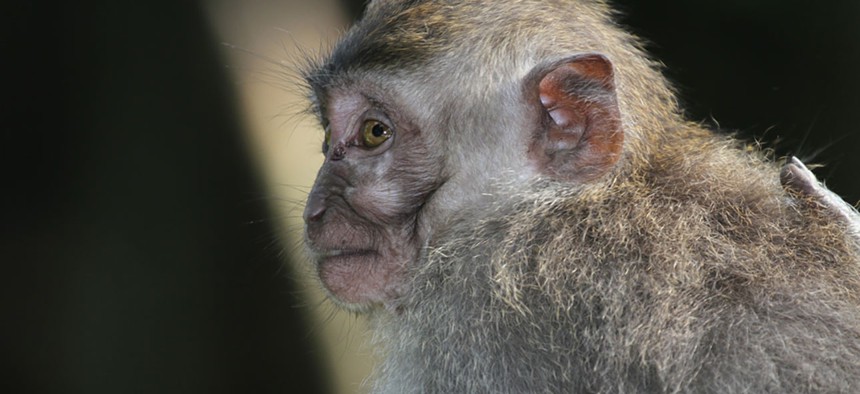More Primates Are Being Used For Lab Research In The U.S. Than Ever Before
The increase comes as other species are being used less and less.
In 2015, there were 767,622 animals used for medical experiments in the U.S., the lowest level since the United States Department of Agriculture began keeping records in the early 1970s. That included roughly 138,000 rabbits, 98,000 hamsters, 11,000 sheep, 46,000 pigs; 20,000 cats, 61,000 dogs, 173,000 guinea pigs, 28,000 “other farm animals,” and nearly 62,000 “nonhuman primates.”
In 2016, the number of animals used for scientific testing rose to 820,812. Last year, it dipped slightly, to 792,168. Today, according to Pew, 52% of Americans are against animal testing. However, there have never been more nonhuman primates used for lab experiments than there are right now.
Increased funding from the National Institutes of Health (NIH), which supports a majority of U.S. primate research, is one factor behind the recent rise in primate testing. The other reason “the numbers are trending up [is] because these animals give us better data,” Jay Rappaport of the Tulane National Primate Research Center in Covington, Louisiana, told Science magazine. “We need them more than ever.”
Others disagree. Thomas Hartung, director of the Johns Hopkins University Center for Alternatives to Animal Testing believes the use of all lab animals, including primates, should be broadly reduced. Scientists and researchers overestimate the value of “almost all animal models,” says Hartung. Computer simulations and other methods that don’t involve the use of live animals can deliver the same results.
The NIH is currently in the process of rebidding at least two requests for proposals to maintain primate colonies in the US. One is currently located at the government-run Dale and Betty Bumpers Vaccine Research Center in Bethesda, Maryland. Another is split between Tulane University in New Orleans, Louisiana and two private companies in Rockville, Maryland, BioQual Inc and Advanced BioScience Laboratory.
Bumpers is focused on developing vaccines for HIV/AIDS, ebola, and influenza, the NIH website says. One of the newly-issued requests for proposal calls for maintaining a colony of up to 1,000 ”Indian-origin” rhesus macaques.
Others disagree. Thomas Hartung, director of the Johns Hopkins University Center for Alternatives to Animal Testing believes the use of all lab animals, including primates, should be broadly reduced. Scientists and researchers overestimate the value of “almost all animal models,” says Hartung. Computer simulations and other methods that don’t involve the use of live animals can deliver the same results.
The NIH is currently in the process of rebidding at least two requestsfor proposals to maintain primate colonies in the US. One is currently located at the government-run Dale and Betty Bumpers Vaccine Research Center in Bethesda, Maryland. Another is split between Tulane University in New Orleans, Louisiana and two private companies in Rockville, Maryland, BioQual Inc and Advanced BioScience Laboratory.
Bumpers is focused on developing vaccines for HIV/AIDS, ebola, and influenza, the NIH website says. One of the newly-issued requests for proposal calls for maintaining a colony of up to 1,000 ”Indian-origin” rhesus macaques.
“Then you’ll have another group of people that are out to try to save the primates,” says Ridenour. “They target labs, universities, march outside people’s homes. They feel like that’s the only means they have—they’ve tried to change the laws and that doesn’t work, so they resort to what we’ve labeled ‘domestic terrorism’ to try to protect the animals.”
Nevertheless, primates continue to be used in research labs—in growing numbers. The increase “represents both the state of the science and the importance of nonhuman primates,” said the NIH in a statement.
To that end, Jon Levine, director of the Wisconsin National Primate Research Center, is disturbed by the current demand for marmosets by neuroscience researchers. The surge in primate demand, Levine told Science, is like “a 10-alarm fire that’s about to be set.”
“Primates have rich emotional and social lives, and suffer greatly when confined and used in laboratory experiments,” says theAmerican Anti-Vivisection Society. “In the wild, they live in groups, often with complex communication and familial social structures, which can be difficult to reproduce in captivity. Furthermore, primates are not just capable of developing relationships; social interaction is important for their psychological well-being. So important, in fact, that some primates will choose companionship over food.”
NEXT STORY: European Countries to Test AI Border Guards



